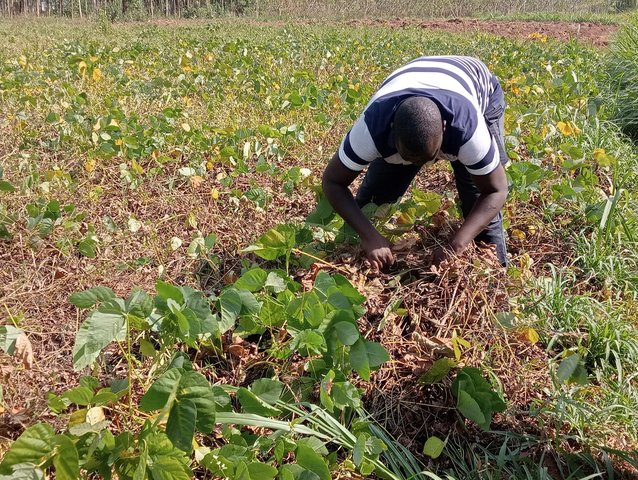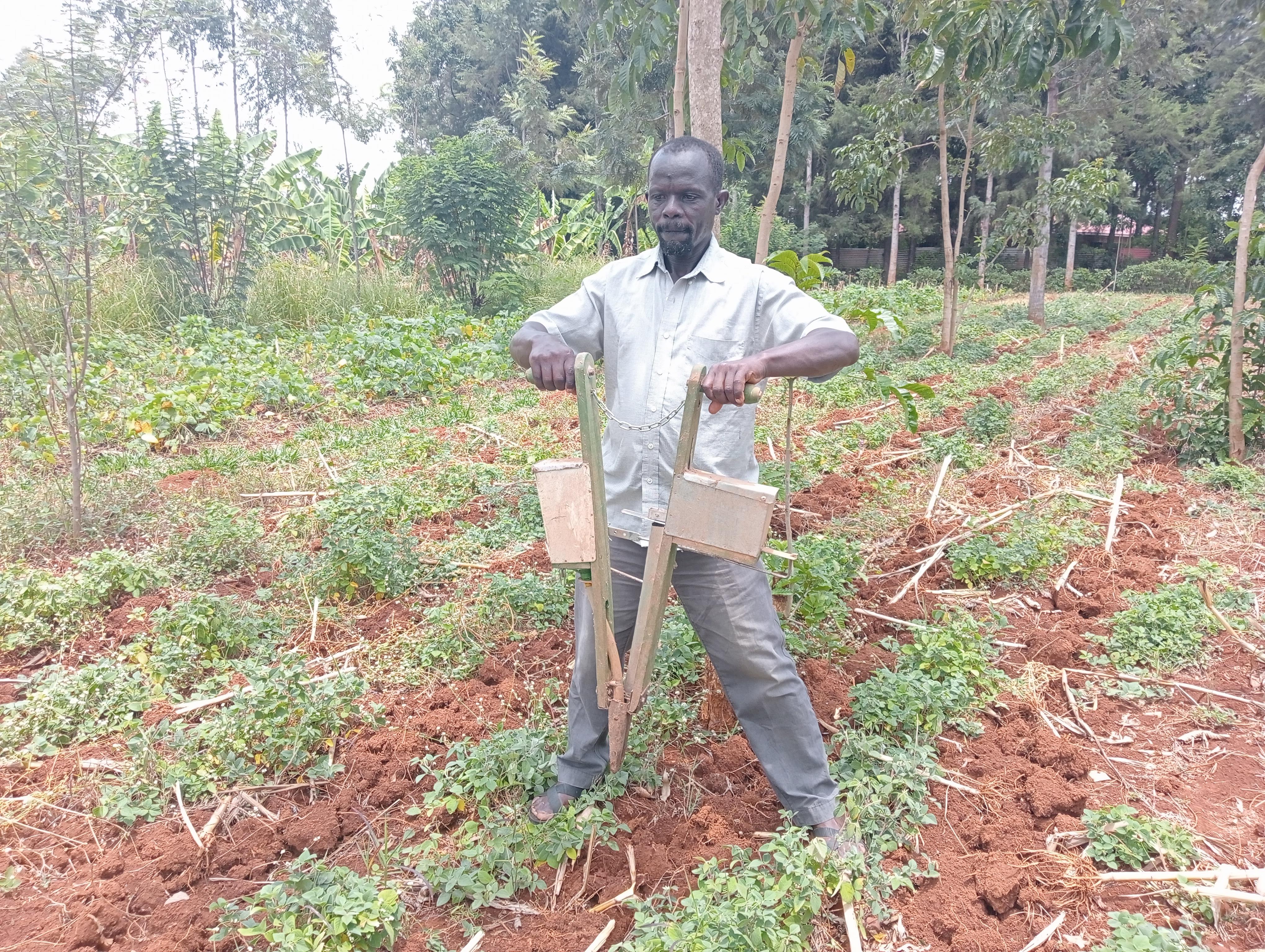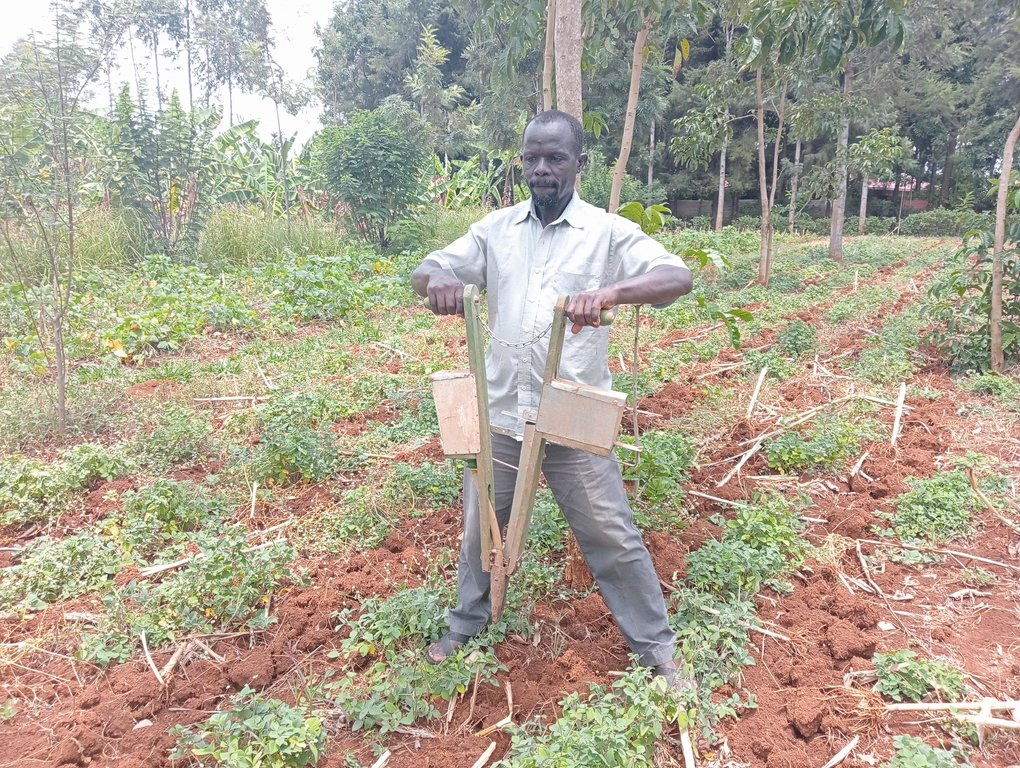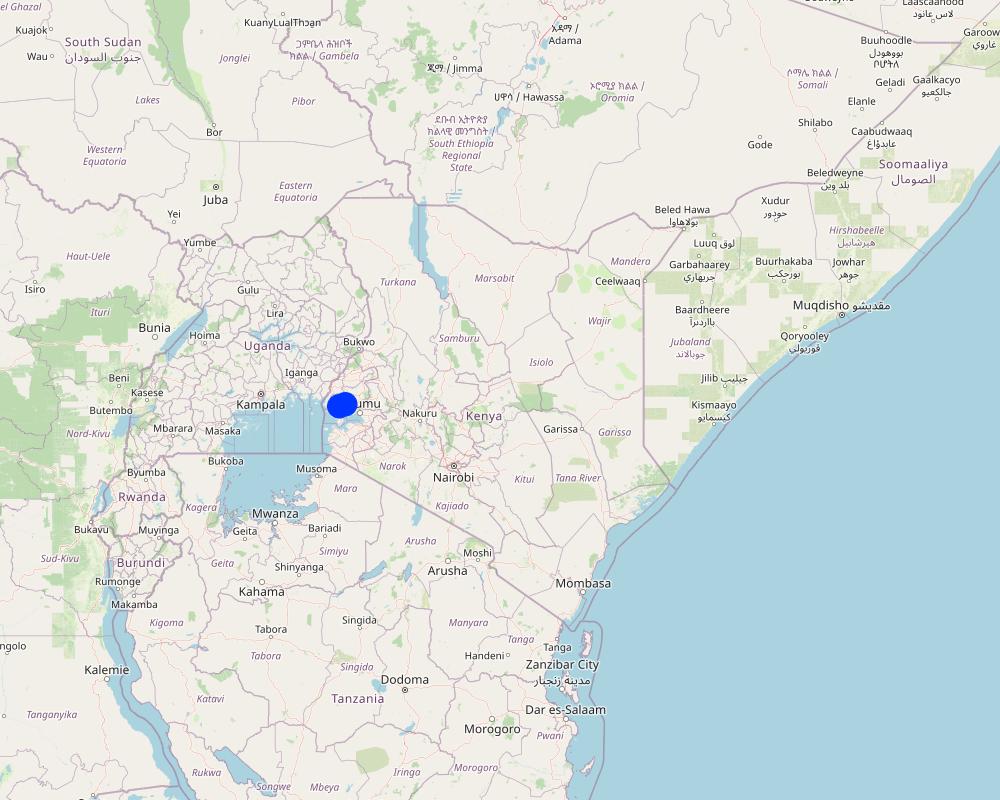Improving farmers' access to tools for conservation agriculture [Quênia]
- Criação:
- Atualização:
- Compilador/a: William Akwanyi
- Editores: Christopher Nyakan, Christopher Nyakan, Innocent Faith, Noel Templer, Tabitha Nekesa, Ahmadou Gaye, Siagbé Golli
- Revisores: William Critchley, Rima Mekdaschi Studer, Sally Bunning
Kuendeleza kilimo hifadhi
approaches_6738 - Quênia
Veja as seções
Expandir tudo Recolher tudo1. Informação geral
1.2 Detalhes do contato das pessoas capacitadas e instituições envolvidas na avaliação e documentação da abordagem
Pessoa(s) capacitada(s)
usuário de terra:
Ong'anda William Ouma
+254 722 236015 / +254 733 529508
GFA farmer
William Ong'anda's farm in Umoyo Village, Gem North Ward, Gem Yala Sub-county, in Siaya County
Quênia
Especialista em GST:
Opiyo Elizaphat
+254 718 288816
opiyoelizaphat@gmail.com
Rural Energy and Food Security Organization (REFSO)
Quênia
Especialista em GST:
Khasakhala Eboche Dave
+254 721 569842
khasakhalaedo@yahoo.com
Agricultural Technology Development Centre (ATDC), Siaya
Agricultural Technology Development Centre (ATDC), Siaya
Quênia
Especialista em GST:
Especialista em GST:
Nome do projeto que facilitou a documentação/avaliação da Abordagem (se relevante)
Soil protection and rehabilitation for food security (ProSo(i)l)Nome da(s) instituição(ões) que facilitou(ram) a documentação/avaliação da Abordagem (se relevante)
Deutsche Gesellschaft für Internationale Zusammenarbeit (GIZ)Nome da(s) instituição(ões) que facilitou(ram) a documentação/avaliação da Abordagem (se relevante)
Alliance Bioversity and International Center for Tropical Agriculture (Alliance Bioversity-CIAT) - Quênia1.3 Condições em relação ao uso da informação documentada através de WOCAT
Quando os dados foram compilados (no campo)?
11/03/2023
O/a compilador/a e a(s) pessoa(s) capacitada(s) aceitam as condições relativas ao uso de dados documentados através da WOCAT:
Sim
1.4 Referência ao(s) questionário(s) sobre tecnologias da GST

Permanent soil cover [Quênia]
Permanent soil cover with cover crops and/or crop residues helps to control soil erosion, suppress weeds and build up soil fertility. It can also add organic matter to the soil.
- Compilador/a: William Akwanyi
2. Descrição da abordagem de GST
2.1 Descrição curta da abordagem
Improving farmers' access to minimum tillage tools is an approach to increasing the adoption of conservation agriculture (CA) through linking them to institutions that fabricate the tools.
2.2 Descrição detalhada da abordagem
Descrição detalhada da abordagem:
Using minimum tillage tools in land preparation, planting, and weed management helps to achieve the principle of minimal soil disturbance in conservation agriculture (CA). However, one of the main challenges facing the adoption of minimum tillage is the high cost of minimum tillage tools. In this approach, the ProSoil project sought to overcome the challenges of accessibility to and high cost of minimum tillage tools. GIZ through Gesellschaft für Agrarprojekte in Übersee (GFA) collaborated with the County Departments of Agriculture’s Agricultural Technology Development Centers (ATDCs) to train local artisans (welders) on how to fabricate minimum tillage tools at reduced cost and ensure easy access. Currently, the farmers can order hand-held minimum tillage tools such as jab planters, hand-held scrapers, shallow weeders, hand-held subsoilers, animal draft power (ADP) subsoilers, ADP rippers, and chaka hoes from ATDCs and local fabricators at reduced costs. In addition, farmers with large pieces of land can hire heavy minimum tillage implements from ATDCs at affordable rents. The project has also partnered with the Kenya Agricultural and Livestock Research Organization (KALRO) to ensure continuous research on the minimum tillage tools and how to improve them based on the different farm settings.
To increase knowledge about minimum tillage, GFA facilitated local community-based organizations to train farmers on the importance of minimum tillage and how to use minimum tillage tools. In Gem Yala area of Siaya County, Kenya, GFA partnered with Rural Energy and Food Security Organization (REFSO) to offer these pieces of training to the farmers through their groups and link them to local manufacturers. Each group consisted of about 25 farmers of which at least 30% were women. The trainings take place at designated venues in localities that are easily accessible by farmers from different locations.
Farmers like this approach because they have been linked to the manufacturers of the tools and have had their capacity built on how to use the tools. They are therefore able to access the tools easily and at affordable prices. They are also motivated to adopt minimum tillage after having benchmarked in other farms are seen how minimum tillage has improved production.
2.3 Fotos da abordagem
2.4 Vídeos da abordagem
Comentários, breve descrição:
A farmer demonstrating how to use a chaka hoe
https://www.youtube.com/watch?v=LMgULi30Jso&ab_channel=WilliamOnura
Data:
11/03/2023
Localização:
William Ong'anda's farm in Umoyo Village, Gem North Ward, Gem Yala Sub-county, in Siaya County
Nome do cinegrafista:
William Onura
Comentários, breve descrição:
A farmer demonstrating how to use a jab planter
https://www.youtube.com/watch?v=1bxoc5IL_pM&ab_channel=WilliamOnura
Data:
11/03/2023
Localização:
William Ong'anda's farm in Umoyo Village, Gem North Ward, Gem Yala Sub-county, in Siaya County
Nome do cinegrafista:
William Onura
Comentários, breve descrição:
A farmer demonstrating how to use a shallow weeder
https://www.youtube.com/watch?v=HMFrEybintM&ab_channel=WilliamOnura
Data:
11/03/2023
Localização:
William Ong'anda's farm in Umoyo Village, Gem North Ward, Gem Yala Sub-county, in Siaya County
Nome do cinegrafista:
William Onura
2.5 País/região/locais onde a abordagem foi aplicada
País:
Quênia
Região/Estado/Província:
Siaya County, Nyanza Region
Especificação adicional de localização:
Gem North Ward in Gem Yala Sub-county
Map
×2.6 Datas de início e término da abordagem
Indique o ano de início:
2020
Comentários:
The approach is still in use.
2.7 Tipo de abordagem
- Baseado em projeto/programa
2.8 Principais metas/objetivos da abordagem
Aim: To increase the adoption of conservation agriculture (CA).
Objective: To improve farmers' access to minimum tillage tools.
2.9 Condição que propiciam ou inibem a implementação de tecnologia/tecnologias aplicada(s) segundo a abordagem
Normas e valores sociais/culturais/religiosos
- Propício
Most farmers have accepted the technology.
Disponibilidade/acesso a recursos e serviços financeiros
- Propício
Less capital investments in maintaining the technologies under the approach.
Colaboração/coordenção de atores
- Propício
Collaboration with Kenya Agricultural, Livestock Research Organisation (KALRO) and Agricultural Technology and Development Centres (ATDC), local artisans, farmer groups, and Rural Energy and Food Security Organization (REFSO) in tool production and training.
Conhecimento sobre GST, acesso a suporte técnico
- Propício
Working together with partners from the county department of agriculture to increase awareness about the tools.
- Inibitivo
Not preferred by farmer who want to have benefits in the short term.
Carga de trabalho, disponibilidade de força de trabalho
- Propício
Reduced workload in the long run.
3. Participação e papel das partes interessadas envolvidas
3.1 Partes interessadas envolvidas na abordagem e seus papéis
- Usuários de terra/comunidades locais
Farmers - men, women, and youth.
Targeted by the technologies and implement them.
- Organizações comunitárias
Umoya Farmers Self-Help Group
Convening farmers during trainings.
- Especialistas em GST/ consultor agrícola
SLM specialists from the ProSoil project, Rural Energy and Food Security Organization (REFSO) and the Agricultural Technology Development Centre (ATDC).
Technical support and advisories to farmers i.e., pass the SLM knowledge to the community resource persons in the community.
- Pesquisadores
Kenya Agricultural and Livestock Research Organization (KALRO)
Continuous research on the CA tools and how to improve them based on the different settings.
- Setor privado
Rural Energy and Food Security Organization (REFSO)
Worked hand-in-hand with other SLM specialists to pass the SLM knowledge to the farmers.
- Governo local
Agricultural extension officers from the county government department of agriculture i.e., the Agricultural Technology Development Centre (ATDC).
Worked hand-in-hand with other SLM specialists to pass the SLM knowledge to the farmers.
- Organização internacional
GIZ
Proposal design and financial support to the implementation of the approach.
Caso várias partes interessadas foram envolvidas, indique a agência líder:
GIZ
3.2 Envolvimento do usuários de terra/comunidades locais nas diferentes fases da abordagem
| Envolvimento do usuários de terra/comunidades locais | Especifique quem estava envolvido e descreva as atividades | |
|---|---|---|
| Iniciação/motivação | Passivo | Farmers in the community, targeted by the SLM technologies under the approach and awareness on access to the minimum tillage tools. |
| Planejamento | Participativo | Agricultural Technology Development Centre (ATDC) and Rural Energy and Food Security Organization (REFSO) jointly agree with farmers on when to engage each other, especially time and venue for training and awareness creation on access to tools. |
| Implementação | Automobilização | Once trained, farmers implement the SLM technologies on their own, but may seek further advice from the SLM specialists where necessary. |
| Monitoramento/avaliação | Passivo | The planning for and conduct of monitoring and/ or evaluation is a role of GIZ and WHH. Farmers are mainly interviewed based on pre-determined questions. |
| Research | Participativo | Continued research by ATDC and KALRO in consultation with farmers to develop tools that are suitable for different settings/ farmlands. |
3.3 Fluxograma (se disponível)
Descrição:
The ProSoil (GIZ and WHH) provides financial support for research by the Kenya Agricultural and Livestock Researchj Organization (KALRO) and for training of farmers by Rural Energy and Food Security Organization (REFSO) and of local artisans by the Agricultural Technology Development Centre (ATDC). Umoya Farmers Self-Help Group convenes farmers for training.
Autor:
William Akwanyi
3.4 Decisão sobre a seleção de tecnologia/tecnologias de GST
Especifique quem decidiu sobre a seleção de tecnologia/tecnologias a serem implementadas:
- todos os atores relevantes, como parte de uma abordagem participativa
Explique:
Decisions on what SLM technologies to implement were made mainly by most partners i.e., GIZ, GFA, KALRO, ATDC, REFSO, and the farmers.
Especifique em que base foram tomadas as decisões:
- Avaliação de conhecimento bem documentado de GST (tomada de decisão baseada em evidências)
- Resultados de pesquisa
4. Suporte técnico, reforço das capacidades e gestão do conhecimento
4.1 Reforço das capacidades/ formação
Foi oferecida formação aos usuários da terra/outras partes interessadas?
Sim
Especifique quem foi capacitado:
- Usuários de terra
- Equipe de campo/consultores
- Local artisans
Caso seja relevante, especifique gênero, idade, status, etnia, etc.
Farmers in their groups (Umoya Farmers Self-Help Group), about 25 farmers in a group, and at least 30% of the number were women.
Tipo de formação:
- Em exercício
- Agricultor para agricultor
- Áreas de demonstração
Assuntos abordados:
1. Benefits of conservation agriculture - minimum tillage
2. Different types of minimum tillage tools
3. How to use different minimum tillage tools
4. Linkage to minimum tillage tools fabricators
4.2 Serviço de consultoria
Os usuários de terra têm acesso a um serviço de consultoria?
Sim
Especifique se foi oferecido serviço de consultoria:
- nas áreas dos usuários da terra
- Em centros permanentes
Descreva/comentários:
SLM specialists advise farmers at their farms whenever they visit them. Farmers can also visit ATDC, KALRO, and REFSO offices for advice. Farmers are also trained at designated venues in groups.
4.3 Fortalecimento da instituição (desenvolvimento organizacional)
As instituições foram fortalecidas ou estabelecidas através da abordagem?
- Sim, moderadamente
Especifique a que nível (níveis) as instituições foram fortalecidas ou estabelecidas:
- Local
Descreva instituição, papéis e responsabilidades, membros, etc.
About 10 REFSO SLM specialists have been capacity built/ trained.
Especifique o tipo de apoio:
- Reforço das capacidades/ formação
Dê mais detalhes:
Training on CA, its benefits, and how and where to access CA tools.
4.4 Monitoramento e avaliação
Monitoramento e avaliação são partes da abordagem?
Sim
Comentários:
GIZ and GFA regularly follows up with local artisans and the Agricultural Technology Development Centre (ATDC) to check on the number of farmers who have bought/ access minimum tillage tools.
Caso afirmativo, esta documentação é destinada a ser utilizada para monitoramento e avaliação?
Não
Comentários:
This documentation in intended for keeping a record of SLM technologies and approaches.
4.5 Pesquisa
A pesquisa foi parte da abordagem?
Sim
- Tool suitability
Dê mais detalhes e indique quem realizou a pesquisa:
Research was done by the Agricultural Technology Development Centre (ATDC) and the Kenya Agricultural and Livestock Research Organization (KALRO) to determine which minimum tillage tools are suitable for which farm settings.
5. Financiamento e apoio material externo
5.1 Orçamento anual para o componente de GST da abordagem
Caso o orçamento exato seja desconhecido, indique a faixa:
- 100.000-1.000.000
Comentários (p. ex. principais fontes de recursos/principais doadores):
Training costs met by GIZ ProSoil project. The cost covers training of a group of about 25 farmers and a group of about 20 local fabricators, and research in tool suitability.
5.2 Apoio financeiro/material concedido aos usuários da terra
Os usuários da terra receberam apoio financeiro/material para a implementação de tecnologia/tecnologias?
Sim
Caso afirmativo, especifique tipo(s) de apoio, condições e fornecedor(es):
GIZ through GFA supported farmers in their groups with minimum tillage tools for demonstration purposes.
5.3 Subsídios para entradas específicas (incluindo mão-de-obra)
- Equipamento
| Especifique quais entradas foram subsidiadas | Em que medida | Especifique os subsídios |
|---|---|---|
| Ferramentas | Totalmente financiado | GIZ through GFA supported farmers in their groups with CA tools for demonstration purposes. |
Se a mão-de-obra pelos usuários da terra foi uma entrada substancial, isso foi:
- Voluntário
Comentários:
Farmers provided labour at demonstration plots.
5.4 Crédito
Foi concedido crédito segundo a abordagem para atividades de GST?
Não
5.5 Outros incentivos ou instrumentos
Foram utilizados outros incentivos ou instrumentos para promover a implementação das tecnologias de GST?
Não
6. Análise de impactos e declarações finais
6.1 Impactos da abordagem
A abordagem concedeu autonomia aos usuários locais de terra, melhorou a participação das partes interessadas?
- Não
- Sim, pouco
- Sim, moderadamente
- Sim, significativamente
Farmers have been empowered with skills on how to use minimum tillage tools and where and how to access them.
A abordagem propiciou a tomada de decisão baseada em evidências?
- Não
- Sim, pouco
- Sim, moderadamente
- Sim, significativamente
Demonstration/ learning plots were important in enabling farmers to learn from the practitioners and from each other based on evidence.
A abordagem auxiliou os usuários da terra a implementar e manter as tecnologias de GST?
- Não
- Sim, pouco
- Sim, moderadamente
- Sim, significativamente
Farmer were trained on minimum tillage.
A abordagem melhorou a coordenação e a implementação economicamente eficiente da GST?
- Não
- Sim, pouco
- Sim, moderadamente
- Sim, significativamente
The Agriculture Technology Development Centre (ATDC) trained local artisans on how to fabricate minimum tillage tools and sells them to farmers at a lower price than that in the other farmers' shops.
A abordagem aprimorou o conhecimento e as capacidades dos usuários da terra para implementar a GST?
- Não
- Sim, pouco
- Sim, moderadamente
- Sim, significativamente
Farmer were taken through pieces of trainings on how to use the minimum tillage tools.
A abordagem aprimorou o conhecimento e as capacidades de outras partes interessadas?
- Não
- Sim, pouco
- Sim, moderadamente
- Sim, significativamente
Local artisans were trained on how to fabricate minimum tillage tools.
A abordagem construiu/fortaleceu instituições, colaboração entre partes interessadas?
- Não
- Sim, pouco
- Sim, moderadamente
- Sim, significativamente
Collaboration between farmers and public extension officers i.e., Agriculture Technology Development Centre (ATDC) SLM specialists. More farmers are consulting these officers for advice.
A abordagem concedeu autonomia aos grupos social e economicamente desfavorecidos?
- Não
- Sim, pouco
- Sim, moderadamente
- Sim, significativamente
The minimum tillage tools provided to the farmers in their groups are used by farmers who cannot afford to buy the tools.
A abordagem resultou em emprego, oportunidades de renda?
- Não
- Sim, pouco
- Sim, moderadamente
- Sim, significativamente
More local artisans were trained on the fabrication of minimum tillage tools. They sell these tools to farmers and earn income.
6.2 Principal motivação dos usuários da terra para implementar a GST
- Produção aumentada
Increased crop yields in the long run.
- Lucro (lucrabilidade) aumentado, melhora da relação custo-benefício
High yields but less costs incurred on inputs and land preparation.
- Degradação do solo reduzida
Minimum tillage minimizes soil disturbance and reduces risks of exposure to agents of erosion.
- Carga de trabalho reduzida
Promotes minimum tillage; hence, reduced need to plough the land.
- melhoria dos conhecimentos e aptidões de GST
Empowered farmers with skills for minimum tillage.
6.3 Atividades de sustentabilidade de abordagem
Os usuários da terra podem manter o que foi implementado através da abordagem (sem apoio externo)?
- Sim
Caso afirmativo, descreva como:
The tools are fabricated and sold to farmers at lower prices than conventional prices i.e., prices in other shops.
6.4 Pontos fortes/vantagens da abordagem
| Pontos fortes/vantagens/oportunidades na visão do usuário da terra |
|---|
| Increased access to minimum tillage tools. |
| The tools are fabricated and sold at lower prices than the prices in other shops. |
| Pontos fortes/vantagens/oportunidades na visão do/a compilador/a ou de outra pessoa capacitada |
|---|
| The ProSoil has linked farmers to local fabricators to ensure ease of access to tools. |
6.5 Pontos fracos, desvantagens da tecnologia e formas de superá-los
| Pontos fracos/desvantagens/riscos na visão do usuário da terra | Como eles podem ser superados? |
|---|---|
| Very few artisans fabricate minimum tillage tools. | Training of more local artisans on how to fabricate the tools and set up businesses. |
| Pontos fracos/vantagens/riscos na visão do/a compilador/a ou de outra pessoa capacitada | Como eles podem ser superados? |
|---|---|
| Inaccessibility of the tools. | Increase awareness among the local artisans so that they can fabricate the tools and set up businesses and provide more affordable solution to farmers. |
7. Referências e links
7.1 Métodos/fontes de informação
- visitas de campo, pesquisas de campo
One visit at one farm. One visit at Siaya ATDC.
- entrevistas com usuários de terras
One farmer interviewed at his farm. Follow-up questions on phone.
- entrevistas com especialistas em GST
ProSoil team, project implementers from GFA, fabricators of the tools from Siaya ATDC, and SLM field support from REFSO interviewed. Follow-up consultation on phone.
- compilação de relatórios e outra documentação existente
At least two online documents reviewed.
7.2 Referências às publicações disponíveis
Título, autor, ano, ISBN:
Conservation Agriculture Technical Manual by SUSTAINET E.A.
Disponível de onde? Custos?
Free download at https://www.weadapt.org/sites/weadapt.org/files/legacy-new/knowledge-base/files/1051/507bcb0bb6e92technical-manual-on-conservation-agriculture-sustanet.pdf
7.3 Links para informação relevante que está disponível online
Título/ descrição:
Conservation agriculture
URL:
https://infonet-biovision.org/EnvironmentalHealth/Conservation-agriculture
Links e módulos
Expandir tudo Recolher tudoLinks

Permanent soil cover [Quênia]
Permanent soil cover with cover crops and/or crop residues helps to control soil erosion, suppress weeds and build up soil fertility. It can also add organic matter to the soil.
- Compilador/a: William Akwanyi
Módulos
Não há módulos





